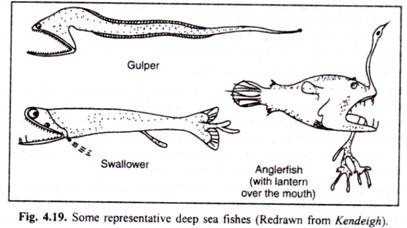Apart from containing bacteria and perhaps fungi, the community of aphotic zone is characteristically animal. Bruun (1957) has called the abyssal the “world’s largest ecological unit”. It is of course an incomplete ecosystem because no producers exist in it.
The oceanic portion of the aphotic zone has been divided by John D. Issacs (1969) into mesopelagic, bathypelagic and benthic zones.
All these division have their own community life called mesopelagic community, bathy – and abyssopelagic communities and benthic community.
In the mesopelagic community the fishes are usually small, laterally compressed, often silvery or greyish in colour, with very large or telescopic eyes, and usually provided with bioluminescent organs. For example, myctophid (Electrona), megamouth shark (Megachiasmodon), and stomiatoid (Bonapartia). Some velvety black or brown fishes also occur here. Invertebrates are reduced in number and variety and tend to be reddish in colour. Since red rays do not penetrate to the depths where these animals live, they are essentially invisible.
The bathy- and abyssopelagic communities are considered as one. The fishes are slender and dark coloured. For example, gulper (Eurypharynx), gulper eel (Saccopharynx) and angler (Linophryne). Pelagic invertebrates include a few endemic species of radiolarians, jelly fish, ctenophores, nemertinians, ostracods, copepods, amphipods, shrimps, and squids. Red colour is more common than at intermediate depths.
Benthic fishes lack swim bladders. Some of them show interesting specialization of the eyes and some have luminous organs. Some examples are tripod fishes (Bathypterois spp) and lizard fish (Bathysaurus). Other benthic animals of the ocean commonly have flat bodies, very long legs, or other means of distributing their weight over the loose, flocculent ooze.
Many species rise above the ooze on stalks. The fragile glass sponges, long stemmed crinoids, and long legged crabs are possible only in very quiet waters that occur at great depths. Skeletons of all animals are fragile because of the difficulty of forming lime at low temperatures. Animal abidance decreases with depth, but even at 8300 m in the hadal zone, some twenty species have been found, chiefly holothurians, polychaetes and sea anemones.
Some of the deep sea animals are capable of traversing the whole ocean from bottom to surface. They may, therefore, feed directly on the rich food supplies in surface waters. But the bulk of the deep sea nekton is adapted to particular water pressures only, and some animals are rigidly confined to limited pressure zones at specific depths. Such animals must, therefore, obtain food either from the dead matter drifting down from the surface, or from within the nekton itself.
The latter condition makes the deep sea the most fiercely competitive environment on earth. The very structure of the animals underlines their violently carnivorous, “eat-or-be-eaten” mode of existence. For example, most of the fishes have enormous mouths equipped with long, sharp teeth, and many can swallow fish larger than themselves (Fig. 4.19).
Since the environment of the deep sea is pitch-black, one of the critical problems for these animals is to find food. A highly developed pressure sense provides one solution. Turbulence in the water created by nearby animals can be recognized and depending on the nature of the turbulence, may be acted upon either, by flight or by approach. Another important adaptation of deep sea animals is bioluminescence. Many of the deep sea animal posses light producing organs.
The light patterns emitted may include a variety of colours and probably serve partly in species recognition (identification of mates). Another function of the light undoubtedly is to warn or to lure. Some of the bioluminescent lures, as in lantern fishes, help to catch the prey.
